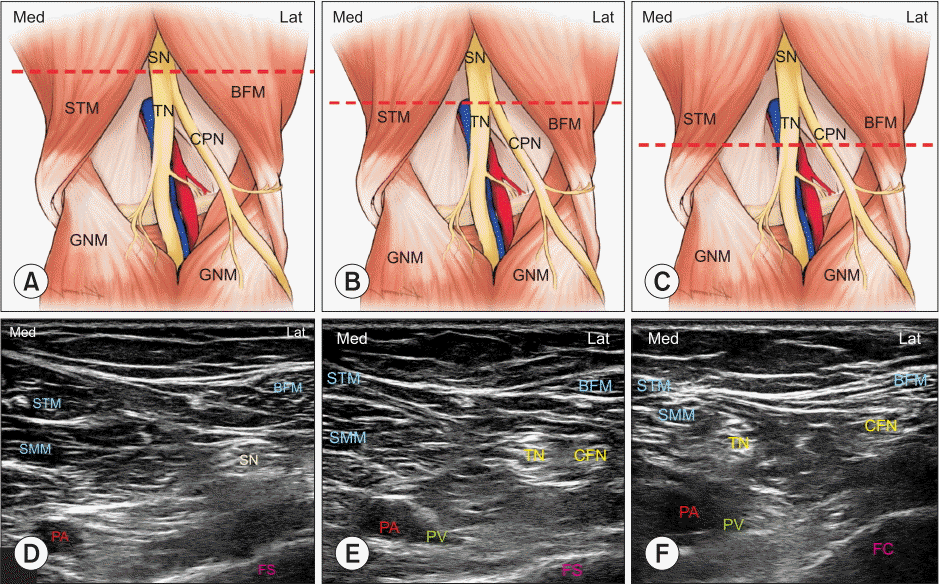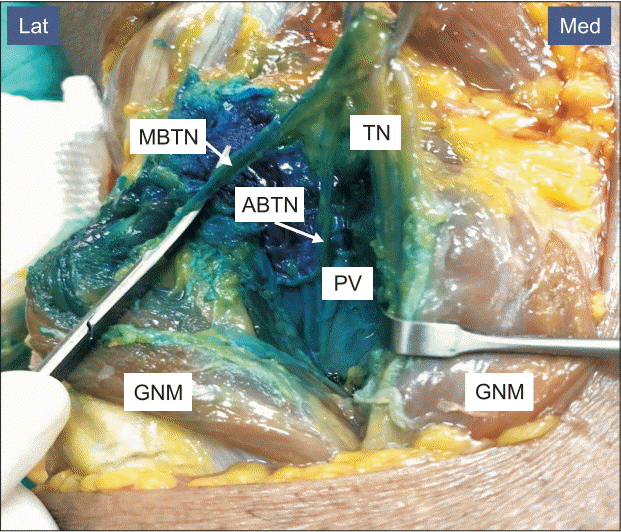1. Husted H. Fast-track hip and knee arthroplasty: clinical and organizational aspects. Acta Orthop Suppl. 2012; 83:1–39.

2. Kehlet H, Thienpont E. Fast-track knee arthroplasty -- status and future challenges. Knee. 2013; 20 Suppl 1:S29–33.

3. Terkawi AS, Mavridis D, Sessler DI, Nunemaker MS, Doais KS, Terkawi RS, et al. Pain management modalities after total knee arthroplasty: a network meta-analysis of 170 randomized controlled trials. Anesthesiology. 2017; 126:923–37.
4. Sharma S, Iorio R, Specht LM, Davies-Lepie S, Healy WL. Complications of femoral nerve block for total knee arthroplasty. Clin Orthop Relat Res. 2010; 468:135–40.

5. Seo JH, Seo SS, Kim DH, Park BY, Park CH, Kim OG. Does combination therapy of popliteal sciatic nerve block and adductor canal block effectively control early postoperative pain after total knee arthroplasty? Knee Surg Relat Res. 2017; 29:276–81.

6. Sinha SK, Abrams JH, Arumugam S, D'Alessio J, Freitas DG, Barnett JT, et al. Femoral nerve block with selective tibial nerve block provides effective analgesia without foot drop after total knee arthroplasty: a prospective, randomized, observer-blinded study. Anesth Analg. 2012; 115:202–6.
7. Silverman ER, Vydyanathan A, Gritsenko K, Shaparin N, Singh N, Downie SA, et al. The anatomic relationship of the tibial nerve to the common peroneal nerve in the popliteal fossa: implications for selective tibial nerve block in total knee arthroplasty. Pain Res Manag. 2017; 2017:7250181.

8. Kampitak W, Tanavalee A, Ngarmukos S, Amarase C. Opioid-sparing analgesia and enhanced recovery after total knee arthroplasty using combined triple nerve blocks with local infiltration analgesia. J Arthroplasty. 2019; 34:295–302.

9. Horner G, Dellon AL. Innervation of the human knee joint and implications for surgery. Clin Orthop Relat Res. 1994; (301):221–6.

10. Kim DH, Beathe JC, Lin Y, YaDeau JT, Maalouf DB, Goytizolo E, et al. Addition of infiltration between the popliteal artery and the capsule of the posterior knee and adductor canal block to periarticular injection enhances postoperative pain control in total knee arthroplasty: a randomized controlled trial. Anesth Analg. 2019; 129:526–35.
11. Thobhani S, Scalercio L, Elliott CE, Nossaman BD, Thomas LC, Yuratich D, et al. Novel regional techniques for total knee arthroplasty promote reduced hospital length of stay: an analysis of 106 patients. Ochsner J. 2017; 17:233–8.
12. Kardash KJ, Noel GP. The SPANK block: a selective sensory, single-injection solution for posterior pain after total knee arthroplasty. Reg Anesth Pain Med. 2016; 41:118–9.
13. Runge C, Bjørn S, Jensen JM, Nielsen ND, Vase M, Holm C, et al. The analgesic effect of a popliteal plexus blockade after total knee arthroplasty: a feasibility study. Acta Anaesthesiol Scand. 2018; 62:1127–32.

14. Gardner E. The innervation of the knee joint. Anat Rec. 1948; 101:109–30.

15. Choi WJ, Hwang SJ, Song JG, Leem JG, Kang YU, Park PH, et al. Radiofrequency treatment relieves chronic knee osteoarthritis pain: a double-blind randomized controlled trial. Pain. 2011; 152:481–7.

16. Yasar E, Kesikburun S, Güzelküçük Ü, Yazar F, Tan AK. Accuracy of ultrasound-guided genicular nerve block: a cadaveric study. Pain Physician. 2015; 18:E899–904.
17. Tran J, Peng PW, Lam K, Baig E, Agur AM, Gofeld M. Anatomical study of the innervation of anterior knee joint capsule: implication for image-guided intervention. Reg Anesth Pain Med. 2018; 43:407–14.
18. Hirasawa Y, Okajima S, Ohta M, Tokioka T. Nerve distribution to the human knee joint: anatomical and immunohistochemical study. Int Orthop. 2000; 24:1–4.

19. Gofeld M. Letter to the editor. Pain. 2014; 155:836–7.

20. Orduña Valls JM, Vallejo R, López Pais P, Soto E, Torres Rodríguez D, Cedeño DL, et al. Anatomic and ultrasonographic evaluation of the knee sensory innervation: a cadaveric study to determine anatomic targets in the treatment of chronic knee pain. Reg Anesth Pain Med. 2017; 42:90–8.
21. Apaydin N, Bozkurt M. Surgical exposures for nerves of the lower limb. In: Nerves and Nerve Injuries. In : Tubbs RS, Rizk E, Shoja MM, Loukas M, Barbaro N, Spinner RJ, editors. Cambridge, Academic Press;2015. p. 139–53.
22. Franco CD, Buvanendran A, Petersohn JD, Menzies RD, Menzies LP. Innervation of the anterior capsule of the human knee: implications for radiofrequency ablation. Reg Anesth Pain Med. 2015; 40:363–8.
23. Runge C, Moriggl B, Børglum J, Bendtsen TF. The spread of ultrasound-guided injectate from the adductor canal to the genicular branch of the posterior obturator nerve and the popliteal plexus: a cadaveric study. Reg Anesth Pain Med. 2017; 42:725–30.
24. Burckett-St Laurant D, Peng P, Girón Arango L, Niazi AU, Chan VW, Agur A, et al. The nerves of the adductor canal and the innervation of the knee: an anatomic study. Reg Anesth Pain Med. 2016; 41:321–7.
25. Hu B, Lin T, Yan SG, Tong SL, Yu JH, Xu JJ, et al. Local infiltration analgesia versus regional blockade for postoperative analgesia in total knee arthroplasty: a meta-analysis of randomized controlled trials. Pain Physician. 2016; 19:205–14.
26. Berninger MT, Friederichs J, Leidinger W, Augat P, Bühren V, Fulghum C, et al. Effect of local infiltration analgesia, peripheral nerve blocks, general and spinal anesthesia on early functional recovery and pain control in unicompartmental knee arthroplasty. BMC Musculoskelet Disord. 2018; 19:249.

27. Morozumi K, Takahashi H, Suzuki T. Distal adductor canal block for administering postoperative analgesia in lower limb surgery. J Clin Anesth. 2018; 44:44.

28. Sztain JF, Khatibi B, Monahan AM, Said ET, Abramson WB, Gabriel RA, et al. Proximal versus distal continuous adductor canal blocks: does varying perineural catheter location influence analgesia? a randomized, subject-masked, controlled clinical trial. Anesth Analg. 2018; 127:240–6.
29. Niesen AD, Harris DJ, Johnson CS, Stoike DE, Smith HM, Jacob AK, et al. Interspace between popliteal artery and posterior capsule of the knee (IPACK) injectate spread: a cadaver study. J Ultrasound Med. 2019; 38:741–5.









 PDF
PDF Citation
Citation Print
Print



 XML Download
XML Download